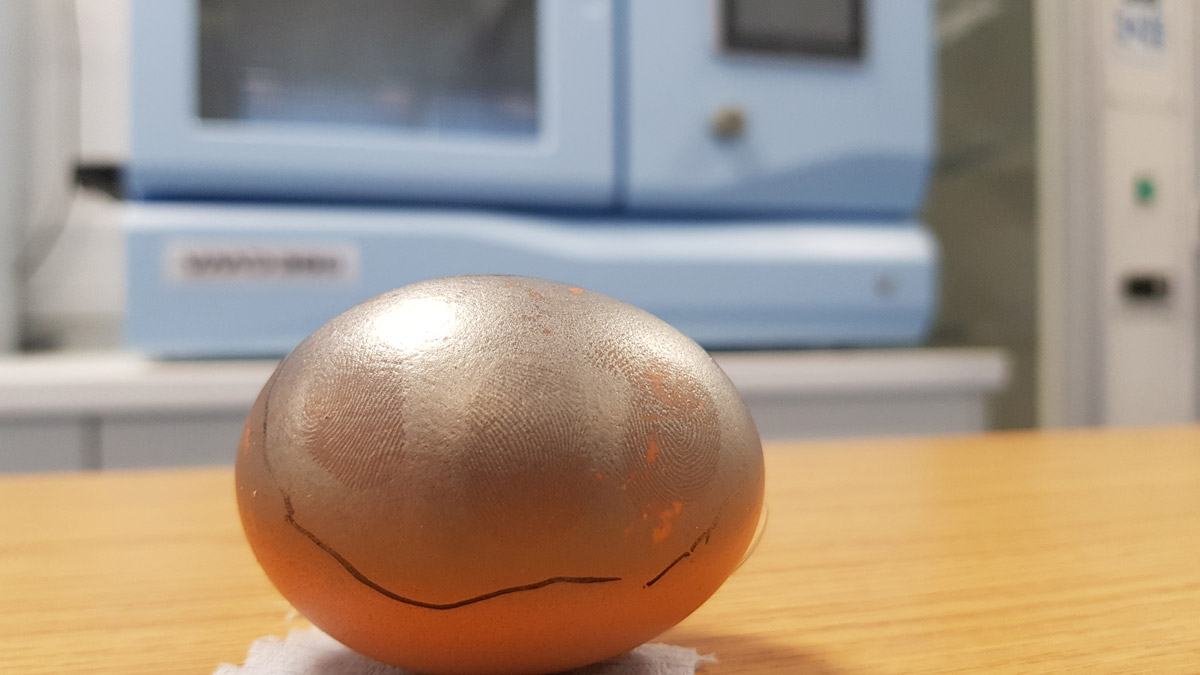The photo of the week series is a weekly series featuring photos taken by our academics and students for our Research Photography Competition, which provides a snapshot of some of the incredible research undertaken across the BU community.
Below: Some eggcellent results obtained from the VMD developing latent fingermarks on a chicken egg using gold and zinc.

This week’s photo of the week, Fingermarks on a chicken egg developed by Vacuum Metal Deposition, is by Alex Otto and Nicola Jones, demonstrators in Forensic Science.
This past October Bournemouth University Forensic department welcomed its newest piece of latent fingermark development equipment to the Crime Scene Training Facility…the VMD 360! Following delivery, Demonstrators in Forensic Science Alex Otto, Nicola Jones and Christopher Dwen received bespoke training from West Technology Forensics over a two day period.
Vacuum Metal Deposition (VMD) is widely recognised as one of, if not the most powerful latent fingermark development techniques currently available. The technique is commonly used to develop latent fingermarks on porous, semi-porous and non-porous exhibits using metals such as gold, zinc and sterling silver. Latent fingermarks developed using VMD are frequently found to be superior quality, and with excellent ridge clarity and higher contrast than fingermarks developed using alternative forensic methods.
The VMD 360 is currently the only table-top vacuum metal deposition unit available in the world and is compact and aesthetically pleasing. Furthermore, with an abundance of potential forensic research still to be undertaken using VMD, such as development of fingermarks on eggs in cases involving rare wild bird egg theft, exciting times lay ahead!
 Photo of the week
Photo of the week Photo of the Week: Riding for gold- 2016 Paralympic Games Prosthetic Limb Development
Photo of the Week: Riding for gold- 2016 Paralympic Games Prosthetic Limb Development Photo of the Week: Tracks in the sand- tracking criminals
Photo of the Week: Tracks in the sand- tracking criminals Photo of the week
Photo of the week










 Six BU contributions 2025 Festival of Social Sciences
Six BU contributions 2025 Festival of Social Sciences BU paper among top 20 most cited papers
BU paper among top 20 most cited papers MSCA Postdoctoral Fellowships 2025 Call
MSCA Postdoctoral Fellowships 2025 Call ERC Advanced Grant 2025 Webinar
ERC Advanced Grant 2025 Webinar Horizon Europe Work Programme 2025 Published
Horizon Europe Work Programme 2025 Published Horizon Europe 2025 Work Programme pre-Published
Horizon Europe 2025 Work Programme pre-Published Update on UKRO services
Update on UKRO services European research project exploring use of ‘virtual twins’ to better manage metabolic associated fatty liver disease
European research project exploring use of ‘virtual twins’ to better manage metabolic associated fatty liver disease